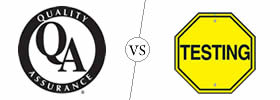Difference between Gorilla Glass and Normal Glass
Key Difference: As compared to normal glass, Gorilla Glass is highly scratch resistant. It is also harder, while also being much thinner than the typical glass. It is also less likely to damage, break or shatter.
 One of the most common problems that smartphone users see is the scratched and broken glass. Every time that phone slips through the fingers and falls smack on the floor screen down, the user will hold their breath and while praying to their God hesitantly pick the phone off of the ground and check if the fall shattered the screen.
One of the most common problems that smartphone users see is the scratched and broken glass. Every time that phone slips through the fingers and falls smack on the floor screen down, the user will hold their breath and while praying to their God hesitantly pick the phone off of the ground and check if the fall shattered the screen.
Due to the large number of shattered screens on smartphones, users keep urging manufacturers to develop screens that are resistant to damage and scratches. This is where Gorilla Glass comes in.
Gorilla Glass is a type of toughened glass created by Corning Inc. Glass is an amorphous solid material that is usually see through. It is created out the chemical compound silica, which is found in abundance in sand. The process of creating a toughened glass includes treating a sheet of glass with chemical baths in high temperatures. This increases the compressive residual stress of the glass which means that the glass is less likely to scratch or damage. Gorilla Glass is created by submerging the glass in a molten alkaline salt bath using ion exchange.
Normal Glass is quite prone to scratches, and more importantly to breakage. As compared to normal glass, Gorilla Glass is highly scratch resistant. It is also harder, while also being much thinner than the typical glass. It is also less likely to damage, break or shatter. Hence, Gorilla Glass is preferred to be used as the top covering on the display screen of electronics such as smartphones, DVD players, mobile gaming consoles, MP3 players, etc.
While the creation and usage of glass has been around for centuries, Gorilla Glass was started developing in 2005. It is essentially a modified type of Corning "Chemcor" glass which was created in 1960. The "Chemcor" glass was a type of strengthened glass that was used until the early 1990s in various commercial and industrial applications, which included automotive, aviation and pharmaceutical uses.
 Corning was asked to develop a type of toughened glass thin enough which could be used in consumer electronics, such as its new iPhone. Gorilla Glass was officially launched in 2007 and by 2010, about 20 percent of mobile handsets worldwide were using Gorilla Glass. This amounted to approximately 200 million units.
Corning was asked to develop a type of toughened glass thin enough which could be used in consumer electronics, such as its new iPhone. Gorilla Glass was officially launched in 2007 and by 2010, about 20 percent of mobile handsets worldwide were using Gorilla Glass. This amounted to approximately 200 million units.
Since then, Corning has continued to develop Gorilla Glass. Gorilla Glass 2 which was launched in 2012 was 20% thinner than Gorilla Glass and 20% more damage resistant. Gorilla Glass 3, launched in 2013, is three times more damage resistant than Gorilla Glass 2, and 40% more scratch-resistant. It is also less brittle and much tougher and flexible than the previous generations of Gorilla Glass. It also comes with silver ion doping that can effectively kill over 90% of bacteria. Corning has recently launched the Gorilla Glass 4, which it claims is twice as strong as any other cover glass in the market. It is also 20-25% thinner than Gorilla Glass 3.
Comparison between Gorilla Glass and Normal Glass:
|
|
Normal Glass |
Gorilla Glass |
|
Type |
Amorphous (non-crystalline) solid material |
Toughened or tempered glass |
|
Manufacturer |
Various |
Corning Inc. |
|
Creation Process |
Silica is combined with soda ash and limestone and melted in a furnace at temperatures of 1700°C. Other materials can be added to produce different colors or properties. |
Glass is immersed in a 400 °C (750 °F) molten alkaline salt bath using ion exchange to create compressive residual stress at the surface to reduce the glass' tendency to crack |
|
Advantages |
Clear, see through, can take on any color, can be blown into infinite shapes. It is also insulating. |
Gorilla Glass is more scratch resistant, damage resistant and resistant to shattering. |
|
Applications |
Optical lenses, prisms, fine glassware, optical fibers, art objects, windows, and for vessels, such as bowls, vases, bottles, jars and drinking glasses. Toughened glass can be used as windshields, and protective windows. |
Primarily as the cover glass for portable electronic devices, including mobile phones, portable media players, portable computer displays, and some television screens. Can also be used for interior design. |
Image Courtesy: elandroidelibre.com, missionrepair.wordpress.com









Comments
Shuravi
Sun, 05/07/2017 - 09:05
Kate
Thu, 10/27/2016 - 23:33
thanks
nana
Tue, 02/17/2015 - 10:42
Add new comment